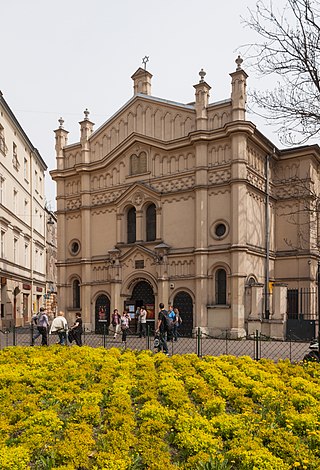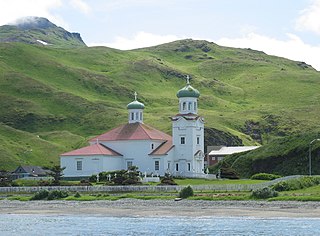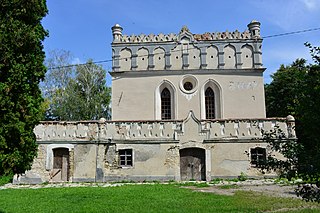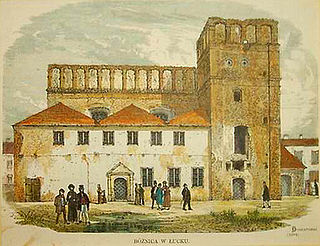


The synagogue in Velyki Mosty in Ukraine, Lviv Oblast was built around 1900. It is now ruined. [1]



The synagogue in Velyki Mosty in Ukraine, Lviv Oblast was built around 1900. It is now ruined. [1]
By the time the synagogue was built there was another synagogue - the old synagogue - nearby. This was ruined during World War I and later disassembled. The new synagogue, which by this time was not completely finished, was partially destroyed but was repaired after the war. During World War II, the Germans burned alive many local Jews in the building. After the war a new roof was installed on the building and it was used as a storage for cattle bones. In the 1950s a storm threw down the whole roof of the main hall and was never replaced. Afterwards the storage was taken away and since then the building stands without any function and deteriorates more and more.
The synagogue is a brick building and consists of the main hall and a narrower and lower narthex. To the north of the synagogue is a one-storied building that is thought to have been the Jewish bath-house (Mikveh). The main hall is nearly square (16 × 16 m) and almost 8 m high; the narthex measures roughly 8 × 16 m. The inside of the main hall is divided by 4 square arches into 9 bays.

Capernaum was a fishing village established during the time of the Hasmoneans, located on the northern shore of the Sea of Galilee. It had a population of about 1500. Archaeological excavations have revealed two ancient synagogues built one over the other. A house turned into a church by the Byzantines is believed to have been the home of Saint Peter.

Kazimierz is a historical district of Kraków and Kraków Old Town, Poland. From its inception in the 14th century to the early 19th century, Kazimierz was an independent city, a royal city of the Crown of the Polish Kingdom, located south of the Old Town of Kraków, separated from it by a branch of the Vistula river. For many centuries, Kazimierz was a place where ethnic Polish and Jewish cultures coexisted and intermingled. The northeastern part of the district was historically Jewish. In 1941, the Jews of Kraków were forcibly relocated by the German occupying forces into the Krakow ghetto just across the river in Podgórze, and most did not survive the war. Today, Kazimierz is one of the major tourist attractions of Krakow and an important center of cultural life of the city.

The Chernobyl Nuclear Power Plant is a nuclear power plant undergoing decommissioning. ChNPP is located near the abandoned city of Pripyat in northern Ukraine 16.5 kilometers (10 mi) northwest of the city of Chernobyl, 16 kilometers (10 mi) from the Belarus–Ukraine border, and about 100 kilometers (62 mi) north of Kyiv. The plant was cooled by an engineered pond, fed by the Pripyat River about 5 kilometers (3 mi) northwest from its juncture with the Dnieper.

Zamość Synagogue is a UNESCO-protected Renaissance synagogue built between 1610 and 1618 in Zamość, southeastern Poland. Erected during the times of the Polish–Lithuanian Commonwealth, it functioned as a place of worship for Polish Jews until World War II, when the Nazis turned the interior into a carpenters' workshop. The structure was spared from destruction and in 1992 it became a UNESCO World Heritage Site alongside the Old City of Zamość.

The Tempel Synagogue is a synagogue in Kraków, Poland, in the Kazimierz district.

High Synagogue is an inactive 16th-century Orthodox Jewish synagogue located in the Kazimierz District of Kraków, Poland. Also known as the "Tall Synagogue", the name corresponds to its height or, alternatively, because the prayer hall was situated upstairs. It is the tallest synagogue in the city and is an example of Late Renaissance architecture.

The Ramban Synagogue is the second oldest active synagogue in the Old City of Jerusalem, after only the Karaite Synagogue. It dates back in its current location to sometime around 1400. Tradition holds that as an institution, it was founded by the scholar and rabbi Moshe ben Nachman, also known as Nachmanides or Ramban, in 1267, but at a more southerly location on Mount Zion, to help rebuild the local Jewish community, which indeed expanded because of the synagogue's presence. The synagogue was moved to its current location around 1400, where it was destroyed in 1474, rebuilt in 1475, and continued functioning until being closed by the Muslim authorities in the late 16th century. The building was used for industrial and commercial purposes until its destruction in the 1948 Jordanian siege of the Jewish Quarter. After the 1967 Six-Day War, it was rebuilt over the old ruins and reconsecrated as a synagogue.

Chęciny is a town in Kielce County, Świętokrzyskie Voivodeship, southern Poland, with 4,361 inhabitants as of December 2021. It was first mentioned in historical documents from 1275, and obtained its city charter in 1325. At that time was one of major urban centers of northern Lesser Poland. The most important sight in Chęciny is the royal castle built in the late 13th or early 14th century on the Castle Hill above the town. It fell into a ruin in the 18th century and remains in that state to this day. For centuries Chęciny had a Jewish community and it had been the center of the Hasidic Chentshin dynasty,

The Church of the Holy Ascension, also known as the Holy Ascension Orthodox Church, is a prominent landmark in Unalaska, the major community of the western Aleutian Islands in southwestern Alaska. The current church was built in 1894, probably on the site of an 1826 church, and likely using timbers and other elements from the older church. It is one of the oldest churches in Alaska, and is significant as the site from which missionaries brought their religion to the local Aleut people. This evangelization effort was so successful that today's Aleut population is still strongly Orthodox. The church was declared a National Historic Landmark for its architecture, and for its role in the history and culture of Alaska. It is the second cathedral church of the Orthodox Church in America Diocese of Alaska, after St. Michael's Cathedral in Sitka.

The Großmarkthalle, in Ostend, Frankfurt am Main, was the city's main wholesale market, especially for fruit and vegetables. It closed on 4 June 2004 and the building now forms part of the Seat of the European Central Bank. It is considered a major example of expressionist architecture.

The Great Suburb Synagogue was a synagogue at Bożnicza-Street 16 in Lviv, Ukraine.

The Central Synagogue of Aleppo,, also known as the Great Synagogue of Aleppo, Joab's Synagogue or Al-Bandara Synagogue, has been a Jewish place of worship since the 5th century C.E. in Aleppo. When it functioned, it was considered the main synagogue of the Syrian Jewish community. The synagogue is noted as being the location where the Aleppo codex was housed for over five hundred years until it was removed during the 1947 Aleppo pogrom, during which the synagogue was burned. The synagogue still stands but is in a ruined state.

The Husiatyn Synagogue (Festungs-Schule) is a former 16th-century synagogue in Husiatyn, Galicia, Ukraine.

The Łańcut Synagogue is a Baroque synagogue in Łańcut, Poland. The Łańcut Synagogue is a rare surviving example of the vaulted synagogues with a bimah-tower, that were built throughout the Polish lands in masonry from the sixteenth through the early nineteenth centuries.

The New Synagogue in Ostrów Wielkopolski, Poland, is located in the city's center on 21 Raszkowska Street, which was the northern edge of the former Jewish district. Currently, this is the only preserved metropolitan synagogue. It is built in the once very popular Moorish Revival style. It is the most precious monument of religious architecture in Ostrów Wielkopolski. Long neglected, the synagogue has been fully restored in 2010. See the municipal website for updates:

The Great Synagogue in Lutsk, Ukraine, is a Renaissance building with a tower. Located in the Jewish quarter, it was the religious, educational and community centre of Lutsk Jews until the invasion of Poland in the Second World War. It was built in 1626 and is a good example of a fortress synagogue. Partially destroyed in 1942, the synagogue was restored in the 1970s. It is now used as a sports club.

Pohrebyshche Synagogue - a former wooden synagogue building, located in Pohrebyshche, a town in Vinnytsia Oblast, Ukraine, was built in the 17th century. It was destroyed in the 20th century.

The synagogue in Pidhaitsi, Ternopil Oblast in Ukraine, was built in the 17th century. Today it is a ruin.

The Great Synagogue or Choral Synagogue in Bila Tserkva, Kyiv Oblast, in Ukraine, was built in the middle of the 19th century. Today the building, which is in good condition, is used as a college.

The Choral Synagogue was a synagogue in Georgievskaya Street 18, in Mariupol, Ukraine. It was established in the house of the merchant Anton Chabanenko in 1882.